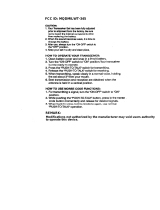
Page 3HX851
8 RADIO SETUP .....................................................................................................64
8.1 DISPLAY ...................................................................................................... 64
8.2 DIMMER ...................................................................................................... 65
8.3 CONTRAST ................................................................................................. 65
8.4 LAMP ........................................................................................................... 66
8.5 PRIORITY CHANNEL ................................................................................ 66
8.6 SCAN TYPE ............................................................................................... 67
8.7 SCAN MEMORY ........................................................................................ 67
8.8 SCAN RESUME ......................................................................................... 68
8.9 KEY BEEP .................................................................................................. 68
8.10 WEATHER ALERT ..................................................................................... 69
8.11 CHANNEL NAME ....................................................................................... 70
8.12 LED SETUP ............................................................................................... 71
9 DSC SETUP MENU ............................................................................................. 72
10 GPS SETUP ......................................................................................................... 73
10.1 UNIT POWER ............................................................................................ 73
10.2 POWER SAVE MODE .............................................................................. 74
10.3 COORDINATE SYSTEM ........................................................................... 75
10.4 PINNING ...................................................................................................... 75
10.5 TIME OFFSET ........................................................................................... 76
10.6 TIME DISPLAY ........................................................................................... 77
10.7 TIME FORMAT ........................................................................................... 77
10.8 SOG UNIT .................................................................................................. 78
10.9 POS DATA PRIORITY ............................................................................... 78
10.10 NMEA OUTPUT ......................................................................................... 79
10.11 ALTITUDE UNIT ......................................................................................... 79
11 COMPASS SETUP ............................................................................................... 80
12 WAYPOINTS.......................................................................................................... 81
12.1 MARKING A POSITION ............................................................................ 81
12.2 STORING WAYPOINTS ............................................................................ 82
12.3 EDITING A WAYPOINT ............................................................................. 83
12.4 DELETING A WAYPOINT ......................................................................... 83
12.5 SAVING A DSC POSITION CALL AS A WAYPOINT ........................... 84
12.6 NAVIGATING TO A SAVED WAYPOINT ................................................ 84
12.7 STOP NAVIGATING TO A WAYPOINT .................................................. 85
12.8 WAYPOINT SETUP ................................................................................... 85
13 MAINTENANCE .................................................................................................... 87
13.1 GENERAL ................................................................................................... 87
13.2 REPLACEMENT PARTS ........................................................................... 87
13.3 FACTORY SERVICE .................................................................................. 88
13.4 TROUBLESHOOTING CHART ................................................................. 88
14 CHANNEL ASSIGNMENTS ................................................................................. 89
15 WARRANTY .......................................................................................................... 96
16 INSTALLATION OF THE FBA-38 ....................................................................... 99
17 SPECIFICATIONS ............................................................................................... 100
17.1 GENERAL ................................................................................................. 100
17.2 TRANSMITTER ......................................................................................... 100
17.3 RECEIVER ................................................................................................ 101
17.4 GPS ........................................................................................................... 101
FCC AND CANADA RADIO LICENSE INFORMATION ......................................102
TABLE OF CONTENTS





















